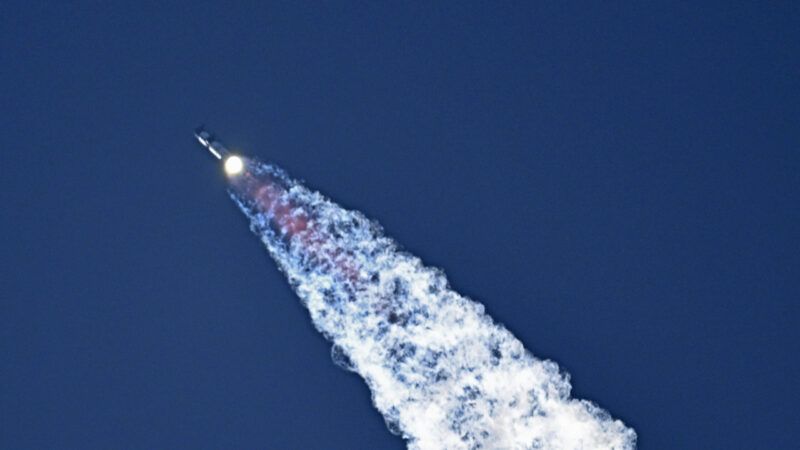SpaceX Makes Progress on Second Test of Starship
The private sector space company overcame red tape and government delays to get to launch day.

On Saturday morning, SpaceX conducted its second test launch of Starship, the super heavy–lift rocket that could one day carry astronauts to the moon and Mars. The vehicle lifted off without incident from SpaceX's Starbase, on the southern tip of Texas, just after 7 a.m. local time. A new water-deluge system deflected the heat of the booster's 33 Raptor engines, preventing the kind of launchpad damage that occurred during the first launch last April—that test ended in self-detonation four minutes into flight, when the ship and the booster failed to separate. For the second run, SpaceX converted the rocket to a "hot staging" system, with the ship's six Raptor engines starting to fire, blasting the top of the booster, as the separation process began. This time, the uncoupling was successful. The booster broke apart shortly thereafter. The second stage carried on another five minutes, rising 90 miles skyward before exploding.
More than twice as powerful as the Apollo program's Saturn V—and designed to be reusable to boot—Starship is already a marvel of human planning and perseverance. But many more launches must occur before it can carry humans into space. It will be a challenge to establish that Starship is reliable, that it can refuel in orbit (a key part of the plan), and that it can safely land on, and take off from, the moon.
Yet all that might be the easy part. Everything depends on SpaceX's ability to jump through regulatory hoops, and the federal bureaucracy's ability to keep pace with a driven private company.
SpaceX was ready for the second test of Starship by early September. Two weeks later, the U.S. Fish and Wildlife Service acknowledged that it had yet to begin the environmental review needed for a launch license. "That is unacceptable," Elon Musk fumed on X. "It is absurd that SpaceX can build a giant rocket faster than they can shuffle paperwork!" Absurd, yes—but hardly unexpected.
The agency moved swiftly—by the standards of the federal government—issuing its review eight weeks later. The main revelation, in line with prior such reviews, is that the Starship program has remarkably little impact on the environment. The new deluge system is of a piece. Most of the more than 300,000 gallons of water emitted during a launch is vaporized by the booster's flame and floats harmlessly away. Most of the water that's left is collected in containment vats. The small quantity of remaining runoff would probably be safe to drink.
Reading these reports, you learn not that SpaceX poses a risk to the environment, but that over-the-top environmental regulations pose a risk to SpaceX. A firm devoted to building rockets finds itself counting birds, combing the beach for sea turtle eggs, trying to calculate the (obviously miniscule) odds that one of its projectiles will hit a whale, and measuring for vibrations near decrepit stone pilings. And woe unto SpaceX should one of its launches, or even one of its trucks, somehow kill one of the dozens of (not endangered) piping plovers known to inhabit the area. "I don't think the public is aware of the madness that goes on," Musk said during a recent interview. He claimed that, as part of an environmental review for launches on the West Coast, SpaceX had to kidnap a seal, strap it down, put headphones on it, and see if the sound of sonic booms made it upset. ("The amazing part," Musk reported, with a chuckle and a photograph, "is how calm the seal was.")
Even if SpaceX can keep the fish and wildlife regulators satisfied and moving—and litigious environmental activists at bay—it could still find itself thwarted by the Federal Aviation Administration (FAA). As Musk noted in 2021, the FAA has historically needed to issue licenses only "for a handful of expendable launches per year." Under the rules designed for that launch pattern, he complained, "humanity will never get to Mars." Although it has sought to improve its approval process, the agency is still struggling. In order to accelerate work on the second Starship launch, officials had to delay work on launches of SpaceX's Falcon 9 rocket—at present the firm's crucial driver of revenue. The problem is set to get worse, as both SpaceX and its competitors step up their launch frequencies.
None of this might seem that important. Doesn't SpaceX dominate the launch market? Isn't the European space industry in shambles? Hasn't the Russian space program become an embarrassment? But as William Gerstenmaier, a SpaceX vice president, points out, the regulatory delays add up. "And eventually," he warns, "we will lose our lead and we will see China land on the moon before we do." The Chinese Communist Party wants, it seems, to seize exclusive control of the moon's water-rich south pole. Along the way, it will probably not slow down for the sake of a few members of a vulnerable bird species.
The United States can uphold rigorous safety standards, guard the environment, and beat China to the moon all the same. The latest Starship test launch shows as much. Unless, that is, it doesn't. Many things could go wrong. NASA could fail to do its part, for example, or Musk's impulsive social media posts could come to haunt SpaceX. But the biggest danger may be a toxic combination of too much red tape, too little state capacity, and a lack of political will to address either one.



Show Comments (65)